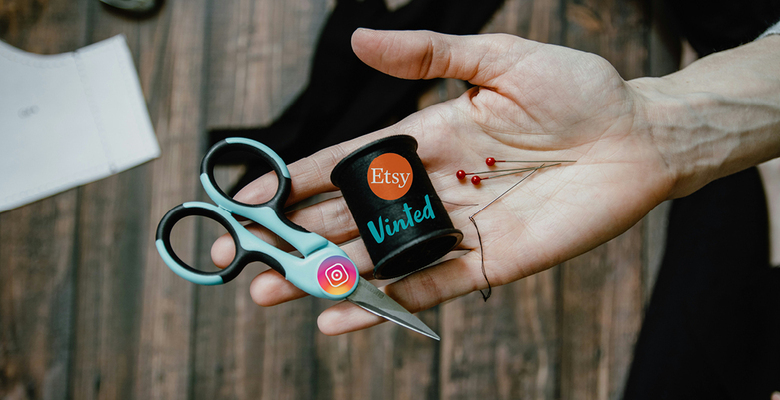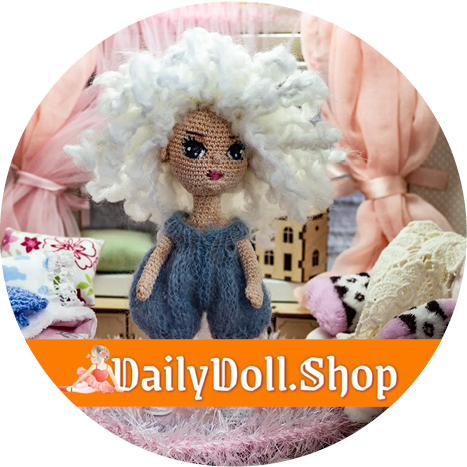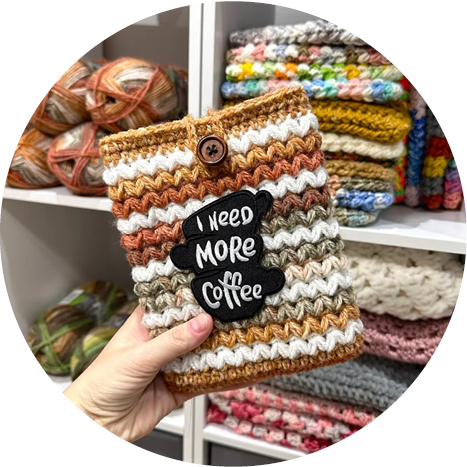
It wasn't so long ago that Companies House reported UK sales on online marketplace Etsy had reached their highest level since the 2020 pandemic. In 2022, turnover on the platform stood at £3.8 million and by 2023 this figure had grown almost three times over, to £9 million. We talked to Russian-speaking handicrafters who sell their works on the various online platforms and marketplaces to learn what difficulties they face and what has affected their choice of platform.

Nadya Mamaeva (London)
My niche is weddings. I make hair decorations and wedding accessories and every petal on my flowers is handmade. I'm always perfecting my skills and learning to combine different techniques. For 13 years now, I have been making a business out of my creations.
I opened my shop on Etsy in 2015, while I was still living in Russia, but I only really started to make a concerted effort to develop it in 2017, shortly after I had moved to Britain. First of all, I began to fill my shop with my own works. They call them ‘listings’. After roughly half a year I already had 120 of them. My first sale was exactly a month after I had started working full-time on the platform in 2017. It was quite an expensive item, costing around £100, so it was an excellent result for a shop with no sales or reviews.
Careful work with SEO helped me to fine-tune how the shop worked and fill its page with the right keywords. The more experience you have of working on this platform, the more data you’ll have to work on, analysing these will help you to further hone your strategy. Only constant work with listings, photos and video as well as optimised, seasonal advertising of your products is guaranteed to bear fruit.
Etsy is an excellent platform for the sale of handmade articles, although, despite its advantages, there are drawbacks. You have to decide whether it's worth your while selling on the platform depending on your aims, chosen niche and individual circumstances. Amongst the strong points I could name are the wide audience; thousands of people visit the marketplace every day and they're all looking for something unique, the low entrance bar as you need no additional investments to create an account and begin sales and the flexible schedule; you can work when you want and as much as you want. After you have created some listings, they continue to work for you even when you're busy doing something else. Etsy has many tools to promote your products including SEO, advertising and the opportunity to take part in exhibitions. What's more, as well as being a marketplace, it's also a large community of creators. You can talk with other salespeople, take part in forums, get advice and find inspiration.
The main drawbacks are the intense competition, especially in popular niches, the commission charged from each sale (there may also be additional costs for the use of payment systems, delivery and packaging), constant changes to the rules of the algorithm which may affect your visibility and sales, difficulties with the platform’s client support and the risk of being undercut by counterfeit goods such as those made in China. All this is bad for the marketplace's reputation. It's also worth bearing in mind that sales on Etsy may have a seasonal nature; demand usually peaks before holidays, for instance, while it may trail off at other periods.
I've already created my own website but I continue to work on Etsy as well. In order to make a well-considered decision about how to market your wares you have to answer yourself these questions: what articles are you planning to sell, who is your target audience, how much time are you ready to spend promoting your products and what are your financial expectations? If you're ready for fierce competition and constant changes and you’re prepared to invest your time and effort in the promotion of your products then Etsy could be an excellent launchpad for your business.
And here's some extra advice for budding handicrafters: take good quality photos as they’re the first things that your potential customers see. Say as much as you can about your products and provide detailed descriptions. Use keywords so they are easy to find, talk to the customers and answer their messages quickly and politely. Good customer service is the key to success. Also, promote your shop by going on social media, taking part in exhibitions and working with bloggers.

Varvara’s view (Birmingham)
I knit bags, shopping bags, pouches for laptops and telephones, charms and keyrings. I started to present my work on Vinted quite recently. I knit as a hobby, to relax and I have an office job at a construction company, so I don't need the money. The knitting needles help me let off steam and then I send off my creations to find new homes.
I chose Vinted because it’s a straightforward and user-friendly app. I only sell in Britain as, to be honest, I'm too lazy to deal with the prices and logistics of international shipments. That's why I haven't made a themed Instagram account. You need energy, know-how and deep pockets to launch one. On top of that, on Vinted they can only buy items I have already knitted, nothing more. I don’t knit to order and I only put things up for sale which are looking for a home. However, the greatest advantage of sales on Vinted was the absence of sales commission. All the added costs are passed on to the customer. However, there are some drawbacks. The site's policy is that the customer is almost always right and when disputes occur, the administration mostly takes their side.
To make sure the products are visible, you need extended descriptions and hashtags. If you’re struggling to come up with a fanciful description you can write something like ‘handmade, boho chic, country style, cottagecore, hippie aesthetic’. There's no point in expecting to earn a lot in this marketplace. People generally come to Vinted for cheap things and if you put something expensive up for sale most likely no one will buy it. I sell my articles at low prices, mostly just to cover the costs of knitting them.

Ilona’s story
I was the main concept creator behind two marketplaces. One, Crealandia, was launched in 2015 and the second, DailyDoll.Shop, opened in 2022.
Crealandia is focused on the sale of digital goods for arts and crafts such as templates for knitwear, embroidery and so on. The platform brings together creative people from all over the world, providing them with the opportunity to sell their creations and instruction materials. Crealandia focuses on digital content which allows the vendors to target a wider, global audience without expenses for the delivery of physical goods.
In turn, DailyDoll.Shop specialises in dolls, miniatures and everything connected with them. The platform draws collectors, craftspeople and artists who create personalised custom dolls and accessories for them. The site has a special focus on training. You can find doll-making courses, templates and teaching materials for learners and experienced craftspeople. This marketplace doesn’t just bring together creative people who sell their creations, it also provides a venue for the exchange of experience and knowledge. Craftspeople can sell their creations and training materials, creating a community where you can find inspiration and acquire skills.
Both platforms concentrate on niche categories of customers and artisans who value creativity and handmade work. The favourable conditions for vendors on our marketplaces are more attractive than on major platforms such as Etsy. One of the main advantages is free listings (on Etsy, salespeople are charged a commission for each listing, usually 20¢ per item). This is especially appealing for small workshops and for creators just starting out; it means they don't have to worry about additional expenses when they’re beginning sales. Yet another significant plus is the site's specialisation in certain categories. While Etsy draws a wide audience and competition between tradespeople is fierce, on Crealandia and DailyDoll.Shop, customers and vendors find a more supportive and welcoming community. This doesn’t just make it easier to find unique products, it also helps creators to interact effectively with their target audience.
The Crealandia and DailyDoll.Shop marketplaces were created by an international Russian-speaking team. Both projects are focused on a global audience whilst providing high-quality Russian language support which is especially convenient for salespeople and customers from Russophone countries; it simplifies problem-solving and all other interactions with the service. The main concept behind our marketplaces comes down to providing novice creators with an alternative to major platforms where the competition is fierce and the conditions are not always favourable.

Anna Eliseeva's experience (Bridlington, Yorkshire)
I began selling things on Etsy seven years ago, although I had a two-year break when my shop closed. I started like everyone else, knitting for personal consumption and then I put my creations on sale to see what would happen. Later on, I bumped into a woman who taught sales. She helped me a lot in the early days. After that, an Etsy group appeared on Facebook and I became an administrator. We have three groups. One is free. On it, there is discussion and advice on how to run a shop on Etsy. There is a charge for membership of the other two, one is for novices and the other for experienced salespeople. In these groups, we work with specific shops. We hold live discussions of promotion mistakes and we look for new ideas. There's no need to sign up for these groups with paid membership, as the free group has a lot of information from the same traders. A lot can also be seen on the YouTube channel.
What are the difficulties? The same as for everyone; finding your niche and establishing yourself in it. I started off with knitwear, but one season I just didn't feel like selling them, so I switched to children's things. Sales were picking up, but I couldn’t be bothered faffing around photographing little children posing in my clothes. Now I've got into knitting pouches for Kindles, which have steady sales. It's very important to stand out and not to have the same things as everyone else. Etsy is jam-packed with all sorts of items. You really do have to put your nose to the grindstone. Unfortunately, until stable steady sales begin, presenting five goods a month is ineffective. I have tried out all the other platforms and similar marketplaces and it didn't work out anywhere. Everybody wanted to buy something unique and exclusive for a pittance. The advantage of Etsy is that it brings together people who understand they will get something unique and are ready to pay for it. Just don't listen to those people who tell you that Etsy is dead. As a rule, they’re the ones who couldn't kickstart their sales on the platform in a week and so became disenchanted.

Kesnia Lee’s experience (Sheffield)
Before Etsy, I had my own site which helped me to sell goods but launching one is an extremely expensive process if you’re on your own, a sole trader without significant capital. It also has to be borne in mind that launching and promoting a site is a full-time job for a marketer whilst you also have to work on the product which you’re selling. In a word, I didn't have the time or money. But I like to knit so I started to look for a place where I could sell my handiwork. The Etsy platform met my requirements more than others such as Amazon or eBay which are more focused on mass-produced items. It's difficult to sell individually made goods on these platforms and it's not always economically viable. At the time, Etsy seemed like the most suitable option.
I used to sell on Etsy five years ago. Back then, they charged one commission to list products, another on sales and a third on delivery costs and all of these had to be included in the price. For this reason, it didn't make economic sense to sell cheaper products on Etsy because the charge for a repeat listing seems to cancel out the money made. The margins just weren't profitable. You have to consider whether the price you’re charging makes the sale worthwhile. When I started to put together my own profile it wasn't all as difficult as it is now. At the time, the platform was not so overcrowded with salespeople. But even then, there was a noticeable trend for vendors of more mass-produced goods to appear on Etsy, who had borrowed designs somewhere and then mass-produced them using products such as tumblers or t-shirts. Of course, it's difficult to compete with these people when your handmade products are a lot more expensive because they are not mass-produced. For instance, compare a hand-blown drinking glass with one simply bought wholesale which has a label stuck on it with the names of the bride and groom. This token ‘personalisation’ is a lot more affordable.
Before Etsy, I used to sell my goods at local designer boutiques which always had stands where you could display your contact information. That’s how I first publicised the address of my Etsy profile. For search engine optimisation, I also had to select some keywords, try them out on customers and see how popular they were. One issue was that if you chose some of the most popular terms but your shop was still not well-established it had no chance of appearing on the first page of search results. It was necessary to do a colossal amount of work analysing and selecting keywords and promoting the goods amongst different demographics, doing professional photo sessions and composing lengthy descriptions of the merchandise covering everything right up to the very smallest detail. Responding to customer inquiries and how you interact with them is also very important.
For me, Etsy is an ordinary sales marketing platform and I can't say whether I'm satisfied with it; some people will make sales work on it and others won't be able to. I know a lot of creative people who started on Etsy but, after years of successfully promoting their products, they gradually lost their client base and attracting customers from fairs and shops via the platform became financially unviable, so it became easier for them to sell on their own sites and not pay the commission. Etsy attracts virtually no new clients and they ask the traders themselves to promote their profiles at different events.
I stopped selling on it myself when I noticed that I had gradually started to adjust myself to what the customers wanted to buy and what was currently fashionable, so I was producing popular seasonal items which were boring for me to make because I had absolutely no emotional investment. When I first got into this, I wanted to create things which I liked and in the rush to roll things out and gain a more stable income stream, I adapted myself to the market. After a while, creativity turned into a routine and I burnt out. In the end, I just decided to change my area of work. I separated my favourite hobby from my job so I could continue to create something new.






